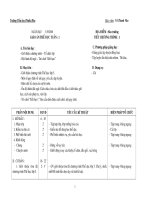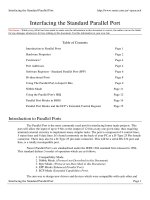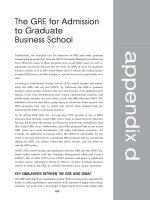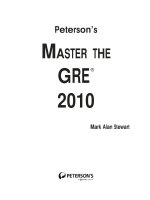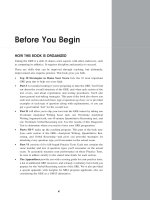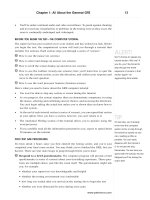Tài liệu BEYOND THE LAW The Bush Administration’s Unlawful Responses in the “War” on Terror pptx
Bạn đang xem bản rút gọn của tài liệu. Xem và tải ngay bản đầy đủ của tài liệu tại đây (3.29 MB, 327 trang )
P1:KNP
9780521884266pre CUFX178/Paust 978 0 521 88426 6 July 27, 2007 11:45
This page intentionally left blank
P1:KNP
9780521884266pre CUFX178/Paust 978 0 521 88426 6 July 27, 2007 11:45
BEYOND THE LAW
This book provides detailed exposition of violations of international law autho-
rized and abetted bysecretmemos,authorizations,andordersoftheBush
administration – in particular, why several Executive claims were in error,
what illegal authorizations were given, what illegal interrogation tactics were
approved, and what illegal transfers and secret detentions occurred. It also
provides the most thorough documentation of cases demonstrating that the
President is bound by the laws of war; that decisions to detain persons, decide
their status, and mistreat them are subject to judicial review during the war;
and that the commander in chief power is subject to restraints by Congress.
Tests for combatant and prisoner of war status are contrasted with Executive
claims and the 2006 Military Commissions Act. Special military commissions
contemplated by President Bush are analyzed along with the Supreme Court’s
decision in Hamdan concerning their illegal structure and procedures, as well
as problems created by the 2006 Military Commissions Act.
Jordan J. Paust is the Mike and Teresa Baker Law Center Professor of Inter-
national Law at the Law Center of the University of Houston. He received an
A.B. and a J.D. from the University of California–Los Angeles and an LL.M.
from the University of Virginia, and he is a J.S.D. Candidate at Yale Univer-
sity. Professor Paust has also been a Visiting Edward Ball Eminent Scholar
University Chair in International Law at Florida State University, a Fulbright
Professor at the University of Salzburg, Austria, and a member of the faculty of
the U.S. Army Judge Advocate General’s School, International Law Division.
He has served on several committees on international law, human rights, laws
of war, terrorism, and the use of force in the American Society of International
Law. He is currently co-chair of the American Society’s International Criminal
Law Interest Group. He was the Chair of the Section on International Law of
the Association of American Law Schools and was on the Executive Council
and the President’s Committee of the American Society of International Law.
He has published works in several countries, many of which address treaties,
customary international law, jurisdiction, human rights, international crimes,
and the incorporation of international law into U.S. domestic law.
i
P1:KNP
9780521884266pre CUFX178/Paust 978 0 521 88426 6 July 27, 2007 11:45
ii
P1:KNP
9780521884266pre CUFX178/Paust 978 0 521 88426 6 July 27, 2007 11:45
BEYOND THE LAW
The Bush Administration’s Unlawful
Responses in the “War” on Terror
JORDAN J. PAUST
University of Houston Law Center
iii
CAMBRIDGE UNIVERSITY PRESS
Cambridge, New York, Melbourne, Madrid, Cape Town, Singapore, São Paulo
Cambridge University Press
The Edinburgh Building, Cambridge CB2 8RU, UK
First published in print format
ISBN-13 978-0-521-88426-6
ISBN-13 978-0-521-71120-3
ISBN-13 978-0-511-35477-9
© Jordan J. Paust 2007
2007
Information on this title: www.cambridge.org/9780521884266
This publication is in copyright. Subject to statutory exception and to the provision of
relevant collective licensing agreements, no reproduction of any part may take place
without the written
p
ermission of Cambrid
g
e University Press.
ISBN-10 0-511-35477-0
ISBN-10 0-521-88426-8
ISBN-10 0-521-71120-7
Cambridge University Press has no responsibility for the persistence or accuracy of urls
for external or third-party internet websites referred to in this publication, and does not
g
uarantee that any content on such websites is, or will remain, accurate or a
pp
ro
p
riate.
Published in the United States of America by Cambridge University Press, New York
www.cambridge.org
hardback
paperback
paperback
eBook (EBL)
eBook (EBL)
hardback
P1:KNP
9780521884266pre CUFX178/Paust 978 0 521 88426 6 July 27, 2007 11:45
CONTENTS
Preface page ix
Acknowledgments and Permissions xiii
ONE
.Executive Plans and Authorizations to Violate International
LawConcerning Treatment and Interrogation of Detainees 1
A. Introduction 1
B. The AfghanWar,LawsofWar,and Human Rights 1
C. Executive Plans and Authorizations 5
D. Illegal Interrogation Tactics 12
E. The Executive Is Bound by International Law 20
F. Con clusion 23
TWO
.Additional Revelations Concerning Treatment, Secret
Detentions, and Secret Renditions 25
A. Introduction 25
B. Actors, Authorizations, Abetments, and Public Paper Trails 26
C. The We Do Not “Torture” Ploy and Refusals to Prosecute 30
D. Secret Detentions, Secret Renditions, and Forced
Disappearance 34
1.DefinitionsofForcedDisappearance in Violation of
International Law 36
2.Impermissibility of Secret Detentions Under International
Law 37
E. Mangling Military Manuals 42
F. Th e 2005 Detainee Treatment Act and Other Binding Laws of
the United States 44
G. Conclusion 45
v
P1:KNP
9780521884266pre CUFX178/Paust 978 0 521 88426 6 July 27, 2007 11:45
vi
CONTENTS
THREE.War and Enemy Status 47
A. Introduction 47
B. The United States Cannot Be at “War” with al Qaeda
or “Terrorism” 48
C. The Status of Various Detainees and the Legal Test for
Combatant Status 50
D. Combatant Immunity 53
E. Legal Tests for Prisoner of War Status 56
F. Da ngerous Consequences Can Arise iftheLegalTests
Are Changed 57
G. The Misconceived Military Commissions Act of 2006 58
H. Conclusion 63
FOUR.Judicial Power to Determine the Status and Rights of
Persons Detained Without Trial 65
A. Introduction 65
B. Propriety ofDetention and Necessity of Judicial Review Under
International Law 67
1.Human Rights Standards in Time of Peace, National
Emergency, or War 67
a. Permissible Detention Under Human Rights Law 67
b. Judicial Review of Detention Under Human Rights Law 68
2.DetentionUnder the Laws of WarDuringTimes of
International Armed Conflict 69
a. Detention of Prisoners of War 69
b. DetentionofOtherPersons 70
c. Judicial Review of Detention and Status Under the Laws
of War 71
C. Judicial Power and Responsibility to Determine the Status and
Rights of Detainees 71
1.TheApplicability of International Law as Law of the United
States 71
2.Judicial Power and Responsibility to Determine Status and
Rights 73
3.TwoCasesBeforetheSupreme Court’s Decision in Hamdi 76
a. Affirming Judicial Responsibility 76
b. Functionally Abdicating Responsibility to Provide a
“Meaningful Judicial Review” 77
D. The Supreme Court’s Decision in Hamdi 80
P1:KNP
9780521884266pre CUFX178/Paust 978 0 521 88426 6 July 27, 2007 11:45
CONTENTS
vii
E. Habeas Corpus Review 81
1.LowerFederal Court Decisions Concerning Habeas Corpus 81
2.TheSupremeCourt’s Decision in Rasul 84
F. Con clusion 84
FIVE.Executive Claims to Unchecked Power 86
A. Legal Constraints on the Commander in Chief Power 86
B. The Commander-Above-the-Law Theory 89
C. Misinterpretations of the 2001 Authorization for Use of
Military Force 91
D. The Malignant Military Commissions Act of 2006 92
E. Conclusion 98
SIX.Antiterrorism Military Commissions 100
A. The 2001 Executive Military Commissions Order 100
B. Rules of Evidence and Procedure for the 2001 Commissions 112
1.SeveralSerious Violations Had Been Continued 113
2.DenialoftheRighttoJudicial Review of Detention 114
3.DenialoftheRighttoReviewbyaCompetent,Independent,
and Impartial Court 116
4.DenialoftheRighttoTrialBeforeaRegularly Constituted,
Competent, Independent, and Impartial Tribunal
Established by Law 117
5.DenialoftheRightstoFair Procedure and Fair Rules
of Evidence 118
6.DenialoftheRighttoCounsel and to Effective
Representation 119
7.Conclusion 119
C. A Regularly Constituted Court with Fair Procedures: The
Supreme Court’s Decision in Hamdan 120
1.ProblemsConcerning Establishment of the Commissions 120
2.ProceduralViolations 121
D. The 2006 Military Commissions 127
E. Conclusion 131
Notes 133
Name Index 301
SubjectIndex 303
P1:KNP
9780521884266pre CUFX178/Paust 978 0 521 88426 6 July 27, 2007 11:45
viii
P1:KNP
9780521884266pre CUFX178/Paust 978 0 521 88426 6 July 27, 2007 11:45
PREFACE
Within a few months after al Qaeda’s unlawful terroristic attacks inside the
United States on September 11, 2001, the Bush administration embarked
on a “dirty war” response to terrorism involving methods of detention,
treatment, and interrogation that Vice President Cheney had generalized
as responses on “the dark side.” The “dirty war” would involve at least
cruel and inhumane treatment of captured human beings and the forced
disappearance of various detained persons, despite the fact that cruel and
inhumane treatment and forced disappearance are well-known examples
of conduct that is absolutely proscribed under several treaties of the United
States and customary international law. In fact, both forms of manifest
illegality are among recognized peremptory prohibitions of the highest
sort that apply in all contexts without exception.
The “dark side” methods, Cheney had argued, should be “done quietly,”
but they were used so widely and for so many years that complete secrecy
was not possible. Opposition by various U.S. military, Federal Bureau of
Investigation (FBI), and Central Intelligence Agency (CIA) personnel con-
tributed to increased public exposure. When pictures of outrageous abuse
of detainees at Abu Ghraib, Iraq, became widely publicized, the secrecy of
Executive plans and authorizations, despite vigorous denial of their exis-
tence, began to unravel. Soon a series of classified memos and letters were
leaked that demonstrated the role that several lawyers and others had played
in attempts to deny international legal protections to al Qaeda and Taliban
detainees, to reclassify their status,and to subject them to unlawful coercive
interrogation tactics with alleged impunity. Yet, even as these and other
evidence of a common plan had been disclosed, the denials, falsehoods,
and misdirections continued – a few bad apples at the bottom; we do not
ix
P1:KNP
9780521884266pre CUFX178/Paust 978 0 521 88426 6 July 27, 2007 11:45
x
PREFACE
“torture”; conduct depicted in the Abu Ghraib photos (e.g., stripping per-
sons naked, hooding, and use of dogs) was not approved; everyone held at
Guantanamo has been properly screened and they are all “terrorists”; there
are no secret detention sites; water-boarding is a professional interrogation
technique.
One of the memos was a February 7, 2002,memorandum by President
Bush that authorized the denial of protections under the 1949 Geneva Con-
ventions to every member of al Qaeda and the Taliban. The existence of
other presidential memos and directives authorizing at least cruel and inhu-
mane treatment and the secret detention and disappearance of human
beings was reported in 2004,butgreater details had emerged by the time
President Bush publicly admitted in September 2006 that, indeed, “tough”
interrogation tactics and secret detentions had been approved and would
be continued by the CIA. These and other actions by the Bush administra-
tion sparked debate and litigation with respect to several matters of great
significance under international, constitutional, and federal statutory law.
In addition to creating individual civil and criminal responsibility for vio-
lations of international law, dirty war tactics have degraded this country,
its values, and its influence. They have degraded those who used them and
degraded those who did not oppose their use. As patriots of democratic
freedom understand, they threaten our democracy and the rule of law.
This book provides a detailed exposition of the types of violations of
treaties of the United States and customary international law authorized
and abetted by previously secret memos, letters, directives, authorizations,
and orders of President Bush, Secretary of Defense Rumsfeld, White House
Counsel Gonzales, and various other lawyers and officials within the Bush
administration – especially in Chapters One and Tw o.These chapters
demonstrate why several of the claims in such memos were in serious and
manifest error; what type of illegal authorizations and orders were actu-
ally given by the President, the Secretary of Defense, and various military
commanders at Guantanamo and in Iraq; what type of other memos and
authorizations existed in support of a common plan to violate the Geneva
Conventions, the Convention Against Torture and Other Cruel, Inhuman
or Degrading Treatment or Punishment, and human rights law; what type
of illegal interrogation tactics were approved and used; what type of illegal
transfers of persons occurred; and what type of unlawful secret deten-
tions occurred. Chapter One also provides detailed attention to various
P1:KNP
9780521884266pre CUFX178/Paust 978 0 521 88426 6 July 27, 2007 11:45
PREFACE
xi
laws of war and human rights relevant to treatment and interrogation of
detained persons and discusses why relevant rights and duties are absolute
and remain so regardless of claims by the President and others to deny
coverage to alleged terrorists and to all enemy combatants; why there can
be leader responsibility for dereliction of duty in addition to the respon-
sibility of direct perpetrators, aiders and abettors, and those who issued
illegal authorizations or orders; and why under our Constitution and ven-
erable judicial decisions and recognitions the President and all within the
Executive branch are and must continue to be bound by the laws of war and
other relevant international law. As noted, during the long history of the
United States, no other President is known to have authorized violations
of the laws of war concerning the transfer, treatment, and interrogation of
human beings.
Chapter Two documents additional roles played by the President and sev-
eral members of his administration and additional insight into the history
of the inner-circle decisions to use the “dirty war” responses to terrorism
that have already partly shaped the President’s legacy. It also pays further
attention to the details of relevant international legal restraints, the ulti-
mate defeat of those within his administration who sought to make room
for “dirty war” tactics in U.S. military manuals, the role of the McCain
Amendment attached to the 2005 Detainee Treatment Act, and the role of
other binding laws of the United States.
Chapter Threeprovides detailed inquiry into actualtreaty-based and cus-
tomary international legal tests for combatant status, combatant immunity,
and prisoner of war status that should be applied with respect to persons
detained during an actual war, such as those in Afghanistan and Iraq. These
are contrasted with some of the claims made by the Executive to deny any
such status and resultant protections to members of the regular armed
forces of the Taliban – claims that are not in the interest of U.S. and foreign
military personnel who might be captured todayorinanyfuture war. Atten-
tion is also paid to the fact that the United States cannot be at “war” with
al Qaeda as such or with a tactic of “terrorism,” certain dangers that can
arise if the tests are changed, and relevant misconceptions and confusion
evidentinthe2006 Military Commissions Act.
The fact that the President is not above the law; that Executive decisions
to detain persons, to decide their status, and to mistreat them are subject to
judicial review even during actual war; and that the President’s commander
P1:KNP
9780521884266pre CUFX178/Paust 978 0 521 88426 6 July 27, 2007 11:45
xii
PREFACE
in chief power is subject to certain restraints by Congress and to absolute
restraints under the laws of war, among other international laws, provide
general bases for the detailed inquiry set forth in Chapters Four and Five.
Like Section E of Chapter One, these chapters provide pivotal details of law
and the numerous judicial decisions that are in complete contrast to the
Bush administration’s unconstitutional and autocratic commander-above-
the-law theory that the President should be able to engage in a “dirty war”
unbound by any inhibiting domestic or international law and free from
either any or any meaningful judicial supervision. Chapter One, Section
E;ChapterTwo,SectionsC.2 and D; and Chapter Five, Section A provide
the most thorough documentation of relevant trends in judicial decision
known to date concerning such matters. Because international law is part
of the law of the United States, has constitutional moorings, is relevant to
the limits of presidential and congressional power, and can influence the
content ofconstitutional and statutory law, some of the legal norms and
trendsinjudicialdecision identified are ofinterrelatedandhistoric concern.
They also should provide a basis for analysis of lawful responses to terrorism
in the future and law’s limitations on Executive power. During war and
threats to national security, it is often the judiciary that has maintained the
line between lawful and unlawful exercises of Executive power, a line that
the Supreme Court maintained in Rasul, Hamdi, and Hamdan.
Chapter Six provides legal analysis of the special military commissions
that the Bush administration contemplated for use in a “war” against al
Qaeda and the Taliban. Serious shortfalls in the President’s 2001 Military
Commissions Order and 2002 Department of Defense Rules of Procedure
and Evidence are analyzed along with the Supreme Court’s landmark deci-
sion in Hamdan concerning the illegal structure of the military commis-
sions and their unlawful procedures. Finally, structural and procedural
problems with the commissions envisioned in the 2006 Military Com-
missions Act are addressed along with the reasons why Supreme Court
decisions require that the Act be interpreted wherever possible in ways that
comply with international law and, in any event, require that treaty law of
the United States have primacy.
In this world, dark enough in places, we need not walk against the light.
The “dirty war” and its dirty consequences should end.
P1:KNP
9780521884266pre CUFX178/Paust 978 0 521 88426 6 July 27, 2007 11:45
ACKNOWLEDGMENTS AND PERMISSIONS
Igratefully acknowledge permissions to reprint revised and updated ver-
sions of the following articles and essays:
Columbia Journal of Transnational Law
Executive Plans and Authorizations to Violate International Law Con-
cerning Treatment and Interrogation of Detainees, 43 Colum. J.
Transnat’l L. 811–63 (2005)
Harvard International Law Journal
Judicial Power to Determine the Status and Rights of Persons Detained
Without Trial, 44 Harv. Int’l L. J. 503–32 (2003)
Michigan Journal of International Law
Antiterrorism Military Commissions: Courting Illegality, 23 Mich. J.
Int’l L. 1–29 (2001)
Antiterrorism Military Commissions: The Ad Hoc DOD Rules of Pro-
cedure, 23 Mich. J. Int’l L. 677–94 (2002)
Utah Law Review
Above the Law: Unlawful Executive Authorizations Regarding Detainee
Treatment, Secret Renditions, Domestic Spying, and Claims to
Unchecked Executive Power, 2007 Utah L.Rev.345(2007)
Wayne Law Review
After 9/11,“No Neutral Ground” with Respect to Human Rights: Exec-
utive Claims and Actions of Special Concern and International Law
Regarding the Disappearance of Detainees, 50 Wayne L. Rev. 79, 83–
93 (2004)
xiii
P1:KNP
9780521884266pre CUFX178/Paust 978 0 521 88426 6 July 27, 2007 11:45
xiv
ACKNOWLEDGMENTS AND PERMISSIONS
Yale Journal of International Law
War and Enemy Status After 9/11:Attacks on the Laws of War, 28 Yale J.
Int’l L. 325–35 (2003)
P1:KNP
9780521884266c01 CUFX178/Paust 978 0 521 88426 6 July 27, 2007 11:49
CHAPTER ONE
EXECUTIVE PLANS AND AUTHORIZATIONS TO VIOLATE
INTERNATIONAL LAW CONCERNING TREATMENT AND
INTERROGATION OF DETAINEES
A. INTRODUCTION
Acommon plan to violate customary and treaty-based international law
concerning the treatment and interrogation of so-called terrorist and
enemy combatant detainees and their supporters captured during the U.S.
war in Afghanistan emerged within the Bush administration in 2002.The
plan was developed within months after the United States had used massive
military force in Afghanistan on October 7, 2001,against local membersof al
Qaeda and “military installations of the Taliban regime”
1
during the war in
Afghanistan that is still ongoing. It was approved in January 2002 and led to
high-level approval and use of unlawful interrogation tactics that year and
in 2003 and 2004.Amajor part of the plan was to deny protections under
the customary laws of war and treaties that require humane treatment of
all persons who are detained during an armed conflict, regardless of their
status and regardless of any claimed necessity to treat human beings inhu-
manely. The common plan and authorizations have criminal implications,
as denials of protections under the laws of war are violations of the laws of
war, which are war crimes.
2
B. THE AFGHAN WAR, LAWS OF WAR, AND HUMAN RIGHTS
The October 7 Afghan war became an international armed conflict between
U.S. combat forces and the Taliban regime, which had been a de facto
Reproduced with permission from the Columbia Journal of Transnational Law.Thischapter is a
revised version of Jordan J. Paust, Executive Plans and Authorizations to Violate International Law
Concerning Treatment and Interrogation of Detainees, 43 Colum. J. Transnat’l L. 811 (2005).
1
P1:KNP
9780521884266c01 CUFX178/Paust 978 0 521 88426 6 July 27, 2007 11:49
2
BEYOND THE LAW
government in control of some 90 percent of the territory of Afghanistan
and had been recognized by a few states as the de jure government of
Afghanistan.
3
The Taliban regime also had been involved in a belligerency
with the Northern Alliance, an armed conflict to which the general laws
of war applied even before U.S. entry into Afghanistan in October 2001.
4
Moreover, it was reported that during the belligerency thousands of mem-
bers of the regular armed forces of Pakistan were involved in the armed
conflict in support of the Taliban,
5
a circumstance that also had interna-
tionalized the armed conflict before to the U.S. intervention.
During an international armed conflict such as the war between the
UnitedStatesandthe Talibanregime, all ofthecustomary lawsof warapply.
6
These also apply during a belligerency.
7
Customary laws of war include
the rights and duties reflected in the 1949 Geneva Conventions,
8
which
had been, and still are, treaties that are binding on the United States and
Afghanistan and their nationals.
9
Common Article 1 ofthe Geneva Conven-
tions expressly requires that all of the signatories respect and ensure respect
for the Conventions “in all circumstances.”
10
It is widely recognized that
common Article 1, among other provisions, thereby assures that Geneva
law is nonderogable, and that alleged necessity poses no exception
11
unless
a particular article allows derogations on the basis of necessity.
12
Article 1
also provides that the duty to respect and to ensure respect for Geneva law
is not based on reciprocal compliance by an enemy
13
but rests on a custom-
ary obligatio erga omnes (an obligation owing by and to all humankind)
14
as well as an express treaty-based obligation assumed by each signatory
that is owing to every other signatory whether or not they are involved in
a particular armed conflict.
15
Furthermore, Article 1 ensures that reprisals
in response to enemy violations are not permissible.
16
Each recognition
above assures that, indeed, as expressly mandated in Article 1,therights
and duties set forth in the Geneva Conventions must be observed “in all
circumstances.”
Common Article 3 of the 1949 Geneva Conventions is an example of
the customary and treaty-based law of war
17
that provides certain rights
and duties with respect to any person who is not taking an active part
in hostilities, thus including any person detained whether or not such a
person had previously engaged in hostilities and regardless of the person’s
status. Common Article 3 also happens to expressly require that all such
persons “shall in all circumstances be treated humanely,” thereby assuring
P1:KNP
9780521884266c01 CUFX178/Paust 978 0 521 88426 6 July 27, 2007 11:49
EXECUTIVE PLANS AND AUTHORIZATIONS TO VIOLATE LAWS
3
that humane treatment is required regardless of claimed necessity or other
alleged excuses. Although common Article 3 was developed in 1949 to
extend protections to certain persons during an insurgency or armed con-
flict not of an international character,
18
common Article 3 now provides a
minimum set of customary rights and obligations during any international
armed conflict.
19
Under the Geneva Conventions, any person who is not a prisoner of war
has rights under the Geneva Civilian Convention, and there is no gap in
the reach of at least some forms of protection and rights of persons.
20
For
example, as noted, common Article 3 assures that any person detained has
certain rights “inall circumstances” and “at any time and in any place what-
soever,” whether the detainee is a prisonerofwar, unprivileged belligerent,
terrorist, or noncombatant.
21
Such absolute rights include the right to be
“treated humanely”; freedom from “violence to life and person”;
22
free-
dom from “cruel treatment and torture”;
23
freedom from “outrages upon
personal dignity, in particular, humiliating and degrading treatment”;
24
and minimum human rights to due process in case of trial.
25
Article 75
of Protocol I tothe1949 Geneva Conventions assures the same minimum
guarantees to every person detained, regardless of status.
26
Although the
United States has not ratified the Protocol, the then Legal Adviser to the
U.S. Secretary of State had rightly noted that the customary “safety-net” of
fundamental guarantees for all persons detained during an international
armed conflict found “expression in Article 75 of Protocol I,” which the
United States regards “as an articulation of safeguards to which all persons
in the hands of an enemy are entitled,” and that even unprivileged belliger-
ents or terrorists “are not ‘outside the law’” and “do not forfeit their right
to humane treatment – a right that belongs to all humankind, in war and
in peace.”
27
In addition to fundamental erga omnes and customary rights and protec-
tions under common Article 3 of the Geneva Conventions and customary
law reflected in Article 75 of Protocol I, there are several other articles
in the Geneva Civilian Convention that provide rights and protections.
Article 4 of the Geneva Civilian Convention assures that foreign persons
outside the territory of the United States are entitled to protections in Parts
II and III of the Convention.
28
Part II applies to “the whole of the popu-
lations of the countries in conflict”
29
and protections therein include the
duty of parties to an armed conflict, “[a]s far as military considerations
P1:KNP
9780521884266c01 CUFX178/Paust 978 0 521 88426 6 July 27, 2007 11:49
4
BEYOND THE LAW
allow to assist persons exposed to grave danger, and to protect them
against ill-treatment.”
30
Within Part III of the Convention, one finds
additional rights and guarantees relevant to the treatment and interroga-
tion of persons.Forexample, Article 27 recognizes that “[p]rotected persons
are entitled, in all circumstances, to respect for their persons, their hon-
our, their family rights, their religious convictions and practices, and their
manners and customs”; it adds that “[t]hey shall at all times be humanely
treated, andshall beprotectedespeciallyagainst all actsof violenceorthreats
thereof and against insults and public curiosity.”
31
Article 31 requires that
“[n]o physical or moral coercion shall be exercised against protected per-
sons, inparticular to obtaininformationfromthemor fromthird parties.”
32
Article 32 supplements the prohibitionsby requiring that parties to the Con-
vention are “prohibited from taking any measure of such a character as to
cause the physical suffering or extermination of protected persons in their
hands [which] applies not only to murder, torture, corporal punish-
ment, mutilation and [otherconduct], butalsoto anyother measures
of brutality whether applied by civilian or military agents.”
33
Article 33
includes the recognition that “all measures of intimidation or of terrorism
are prohibited.”
34
Customary and treaty-based human rights are also relevant to the treat-
ment and interrogation of human beings, and human rights law continues
to apply during war.
35
Human rights law provides basic rights for every
human being and includes the fundamental and inalienable right to human
dignity.
36
Some human rights are derogable under special tests in times of
public emergency or other necessity,
37
but many human rights arenondero-
gable andare therefore absolute regardless of claims of necessity during war
or other public emergency and regardless of any other putative excuse.
38
Certain human rights are also peremptory jus cogens that cannot be dero-
gated from and that preempt any other laws.
39
Thus, in every circumstance every human being has some forms of pro-
tection under human rights law. With respect to treatment and interroga-
tion of human beings, customary and treaty-based human rights law that is
nonderogable under all circumstances and is also part of peremptory rights
and prohibitions (jus cogens)requires that “[n]o one shall be subjected to
torture or to cruel, inhuman or degrading treatment or punishment.”
40
As customary and peremptory rights and prohibitions jus cogens,thepro-
hibitions of torture and cruel, inhuman, or degrading treatment apply
P1:KNP
9780521884266c01 CUFX178/Paust 978 0 521 88426 6 July 27, 2007 11:49
EXECUTIVE PLANS AND AUTHORIZATIONS TO VIOLATE LAWS
5
universally and without any limitations in allegedly valid reservations or
understandings during ratification of a relevant treaty,
41
such as those
attempted with respect to the International Covenant on Civil and Politi-
cal Rights (ICCPR)
42
or the Convention Against Torture and Other Cruel,
Inhuman or Degrading Treatment or Punishment.
43
C. EXECUTIVE PLANS AND AUTHORIZATIONS
Despite such clear and absolute requirements under the laws of war and
human rights law, the plan within the Bush administration to deny protec-
tions under international law that led to approval and use of illegal inter-
rogation tactics rested on what White House Counsel Alberto Gonzales
advised President Bush in January 2002 was a supposed “high premium
on other factors, such as the ability to quickly obtain information,”
44
sup-
posed “military necessity,”
45
and a claim that a supposedly “new paradigm
renders obsolete Geneva’s strict limitations on questioning.”
46
However,
none of these claims could possibly justify the plan to violate Geneva law
and nonderogable human rights. Moreover, the Gonzales memo clearly
placed the President on notice that the Geneva Conventions provide “strict
limitations on questioning,” but the President’s subsequent decisions and
authorizations, coupled with recommendations, decisions, authorizations,
and ordersofotherswithin the administration and the military,setthe com-
mon plan to deny Geneva protections and use illegal interrogation tactics
in motion.
The 2002 Gonzales memo to the President addressed certain war crimes
under one of two federal statutes that can be used to prosecute U.S. and for-
eign nationals for war crimes.
47
It expressly noted that a war crime includes
“any violation of common Article 3 (suchas‘outrages against personal
dignity’)”
48
and rightly warned that “[s]ome of these provisions apply (if
the GPW
49
applies) regardless of whether the individual being detained
qualifies as a POW,” a point that Legal Adviser to the Secretary of State
William H. Taft IV had made two days earlier in a letter to John Yoo at
the Office of Legal Counsel (OLC), Department of Justice (DOJ): “Even
those terrorists captured in Afghanistan areentitledtothefundamental
humane treatment standards of Common Article 3 of the Geneva Conven-
tions – the text, negotiating record, subsequent practice and legal opinion
P1:KNP
9780521884266c01 CUFX178/Paust 978 0 521 88426 6 July 27, 2007 11:49
6
BEYOND THE LAW
confirm that Common Article 3 provides the minimal standards applicable
in any armed conflict.”
50
The plan to deny Geneva protections and to authorize illegal interroga-
tion tactics would be furthered, Gonzales opined, by “[a]dhering to your
determination that GPW does not apply.”
51
The memo to the President
further claimed that “[a] determination that GPW is not applicable to
the Taliban would mean that . . . [the federal criminal statute addressed
supposedly] would not applyto actions takenwith respect to the Taliban.”
52
The latter claim is not true in view of numerous judicial decisions through-
out our history reviewing Executive decisions concerning the status of per-
sons during war
53
and affirming constitutionally based judicial power ulti-
mately to decide whether and how the laws of war, as relevant law, apply,
54
points documented in detail in Chapter Four.Nonetheless, the claim is evi-
dence of an unprincipled plan to evade the reach of law and to take actions
in violation of Geneva law while seeking to avoid criminal sanctions. All
were on notice of what the application of Geneva law required.
As the Gonzales memo noted, the President had previously followed the
White House Counsel’s advice on January 18 as well as that set forth in a
Department of Justice formal legal opinion and the President had decided,
in error, that GPW did not apply during the war in Afghanistan.
55
The
Gonzales memo noted that “the Legal Adviser to the Secretary of State
has expressed a different view,” but Gonzales pressed the plan to adhere “to
your determination thatGPW does not apply” precisely because among the
“consequences of a decision to adhere toyourearlierdeterminationthat
the GPW does not apply to the Taliban” would be the supposed avoidance
of “Geneva’s strict limitations on questioning” so as to enhance “the ability
to quickly obtain information.” Another supposed consequence would be
the avoidance of “foreclosing options for the future, particularly against
nonstate actors.” Most important, Gonzales supposed, a consequence of
the determination would be a “[s]ubstantial reduc[tion] of the threat of
domestic criminal prosecution [of U.S. personnel] under the War Crimes
Act (18 U.S.C. 2441)” because it “would mean that Section 2441 would not
apply to actions taken with respect to the Taliban,” and the determination
“would provide a solid defenseto any future prosecution.”
56
As noted above
however, Geneva law clearly did apply and the President cannot foreclose
judicial recognition of the reach and application of international law.
The day after Gonzales crafted his memo, an outraged Secretary of State
Colin Powell sent a memo to the White House Counsel and the Assistant to
P1:KNP
9780521884266c01 CUFX178/Paust 978 0 521 88426 6 July 27, 2007 11:49
EXECUTIVE PLANS AND AUTHORIZATIONS TO VIOLATE LAWS
7
the President for National Security Affairs warning that “[t]he United States
has never determined that the GPW did not apply to an armed conflict in
which its forceshavebeenengaged [T]he GPW was intended to cover
all types of armed conflict and did not by its terms limit its application.”
57
Such a warning was reiterated a week later in a memo by the Legal Adviser
to the Department of State, William H. Taft IV, to White House Counsel
Gonzales:
The President should know that a decision that the Conventions do apply
is consistent with the plain language of the Conventions and the unvaried
practice of the United States in introducing its forces into conflict over
fifty years. It is consistent with the advice of DOS lawyers and, as far
as is known, the position of every other party to the Conventions. It is
consistent with UN Security Council Resolution 1193 affirming that “All
parties to the conflict [in Afghanistan] are bound to comply with their
obligations under international humanitarian law and in particular the
Geneva Conventions.”
58
Attorney General John Ashcroft, however, had been opposed to similar
advice from the National Security Council and had urged the President to
deny applicability of the Geneva Conventions and their protections in an
effort to avoid criminal sanctions because:
aPresidential determination against treaty applicability would provide
the highest assurance that no court would subsequently entertain charges
that American military officers, intelligence officials, or law enforcement
officials violatedGenevaConvention rulesrelating tofieldconduct, deten-
tion conduct or interrogation of detainees. The War Crimes Act of 1996
makes violation of parts of the Geneva Convention a crime in the United
States.
59
The President adhered to the erroneous decision until February 7, 2002
(four months after U.S. entry into the Afghan war), when the White House
reversed itself and announced that the Geneva Conventions applied to the
war in Afghanistan, but in a memorandum issued on that date the Presi-
dent authorized the denial of protections under common Article 3 of the
Geneva Conventions to every member of al Qaeda and the Taliban.
60
This
memorandum also authorized the denial of protections more generally by
ordering that humane treatment be merely “in a manner consistent with
the principles of Geneva” and then only “to the extent appropriate and
P1:KNP
9780521884266c01 CUFX178/Paust 978 0 521 88426 6 July 27, 2007 11:49
8
BEYOND THE LAW
consistent with military necessity,” despite the fact that (1)farmore than
the “principles”ofGeneva lawapply,(2)itisnot“appropriate”todenytreat-
ment required by Geneva law, and (3)alleged military necessity does not
justify the denial of treatment required by Geneva law. The memorandum’s
language limiting protection “to the extent appropriate” is potentially one
of the broadest putative excuses for violations of Geneva law. Necessarily,
the President’s memorandum of February 7, 2002,authorized and ordered
the denial of treatment required by the Geneva Conventions and, therefore,
necessarily authorized and ordered violations of the Geneva Conventions,
which are war crimes.
With respect to members of al Qaeda in particular, the White House
announced at that time that members of al Qaeda “are not covered by the
Geneva Convention” and will continue to be denied Geneva law protec-
tions, supposedly because al Qaeda “cannot be considered a state party to
the Geneva Convention.”
61
As noted soon thereafter, however:
[t]he White House statement demonstrates remarkable ignorance of the
nature and reach of treaties and customary international law. First, any
member ofal Qaeda who isa national ofa state thathas ratified the relevant
treaties is protected by them. Nearly every state, including Saudi Arabia,
is a signatory to these treaties. Second, the 1949 Geneva Conventions are
part of customary international law that is universally applicable in times
of armed conflict and, as such, protect all human beings according to
their terms. Third, common Article 3 provides nonderogable protections
and due process guarantees for every human being who is captured and,
like common Article 1,assures their application in all circumstances. Also,
international terrorism and terrorism in war are not new and clearly were
contemplated during the drafting of the treaties.
62
The Legal Adviser to the State Department had also aptly warned that the
portion of the Gonzales memo:
[s]uggesting a distinction between our conflict with al Qaeda and our
conflict with the Taliban does not conform to the structure of the Con-
ventions. The Conventions call for a decision whether they apply to the
conflict in Afghanistan. If they do, their provisions are applicable to all
persons involvedinthatconflict–alQaeda,Taliban,NorthernAlliance,
U.S. troops, civilians, etc.
63
P1:KNP
9780521884266c01 CUFX178/Paust 978 0 521 88426 6 July 27, 2007 11:49
EXECUTIVE PLANS AND AUTHORIZATIONS TO VIOLATE LAWS
9
The plan involving White House Counsel Gonzales and President Bush
evidenced in the Gonzales memo was legally inept for an additional reason.
The memo openly admitted the unavoidable fact that “the customary laws
of war would still be available. . . . Moreover, even if GPW is not applicable,
we can still bring war crimes charges” against members of al Qaeda and the
Taliban with respect to violations of the customary laws of war occurring
during the war in Afghanistan.
64
Thus, the plan recognized that the cus-
tomary laws of war apply to the war in Afghanistan and apply to members
of al Qaeda and the Taliban, but the plan involved a design and decision to
refuse to apply provisions of the Geneva Conventions that provide protec-
tions for such persons despite the unavoidable facts: (1)that as treaty law the
Geneva protections also apply during the international armed conflict in
Afghanistan; and (2)that Geneva protections are also widely recognized
as constituting part of the customary laws of war that apply to interna-
tional armed conflicts like the war in Afghanistan and, thus, to members of
al Qaeda and the Taliban during and within that armed conflict.
65
More-
over, the Gonzales memo had paid no attention to similar protections and
requirements under customary and treaty-based human rights law.
Behind the Gonzales-Bush plan was a memorandum written on Jan-
uary 9, 2002,that had also addressed possible war crime responsibility of
U.S. nationals and designs for attempted avoidance of international and
domestic criminal responsibility for interrogation tactics (that would later
be approved) by claiming that Geneva law did not protect members of al
Qaeda or the Taliban. The memo was written in the Office of Legal Coun-
sel of the Department of Justice by John Yoo and Robert J. Delahunty for
William J. Haynes II, General Counsel of the Department of Defense.
66
It
was the DOJ memo thathad been referred to in the Gonzales memo to Pres-
ident Bush and it was quickly “endorsed by top lawyers in the White House,
the Pentagon and the vice president’s office”
67
to furtherthecommon plan.
The Yoo-Delahunty memo had argued in support of denial of Geneva
protections for members of al Qaeda that “the laws of armed conflict . . .
[based in] treaties do not protect members of the al Qaeda organization,
which as anon-state actor cannot be aparty to the international agreements
governing war.”
68
As noted, however,protectionofalQaedapersonsduring
an armed conflict does not depend on whether al Qaeda is a state actor
or a party to law of war treaties.
69
The Yoo-Delahunty memo recognized
that violations of common Article 3 of the Geneva Conventions are war
